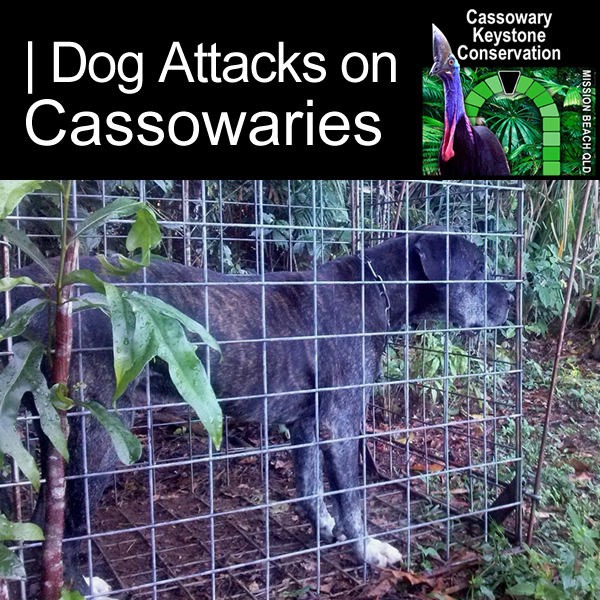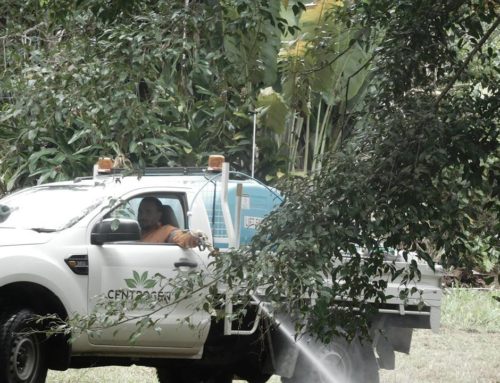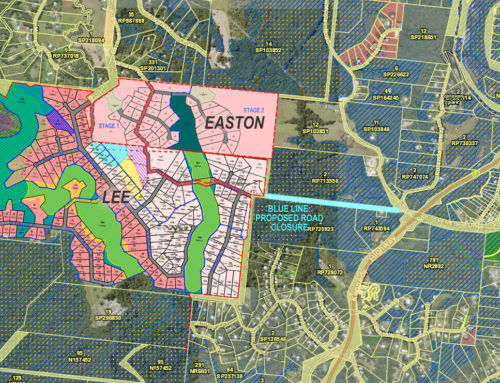Date: 2 February 2017
Submitted by: Ingrid Marker, Cassowary Keystone Conservation
A dogs teeth and jaws have evolved to capture, kill and eat prey, their canine teeth can puncture, tear and penetrate deeper than their length and their jaws have hundreds of pounds of pressure designed to crush tissue and bone.
Only 24 dog attacks on cassowaries have been formally recorded since 20031 and 82% of these were fatal. The age demographic of birds attacked were; adults 37.5%, sub-adults 33%, chicks 21%, unknown 8%. As chicks are vulnerable to all sizes of dogs as well as cats, it is likely this age group is under represented due to the lack of visibility and fast decomposition of their smaller body size. Only one of these 24 attacks was witnessed making it likely that the remaining birds were found dead or fatally injured in absence of any dogs. This again high lights the difficulties in acquiring the evidence needed for prosecution. 75% of these attacks occurred on the Cassowary Coast, which is likely due to; higher densities of dogs and humans (to discover attacked birds), more fragmented and accessible cassowary habitat and the habituated nature of cassowaries in this area. An earlier monitoring program around Mission Beach between 1990-92 found dog attack to again be the second highest source of mortality with attacks occurring in rural areas and along the edges of residential development 2. Sub-adults were the age class most affected and all attacks were by packs of 2, 3 and 5 dogs. In the case of the Daintree it is likely there are less dog attacks yet because of a more spread out human population and denser, more inaccessible forest these attacks are even less likely to be discovered or witnessed.
Puncture wounds on wildlife caused by a bite or scratch from a domestic predatory animals (dogs and cats) are often not obvious to the witnessing pet owner and can cause severe haemorrhages, tissue, organ and bone damage. Other fatal dog and cat attack injuries include lacerations, skin tears, amputations, fractures, dislocations, crushing of vital organs and blood poisoning (toxaemia) from mouth bacteria in a pets mouth. An attack, chase or harassment can also cause fatal stress myopathy and rhabdomyolysisin the days following3.
Whilst small dogs can still chase and kill cassowary chicks an adult cassowary is more likely to be able to defend his young. Dogs over 10 kg were responsible for 96% of attacks on koalas in SE Qld and the likelihood of a fatal attack was positively correlated to dog size. It was also found that there was a higher incidence of attack if there were two or more dogs present at a property4.
3 other verified dog attacks
Cassowary researcher Dr H. Campbell released a radio-collared juvenile on the Basilisk range, 85km south of Cairns, in 2013 which was killed by dogs within 48 hours of release. Two other dog attack fatalities were found by Dr Campbell during fieldwork, one adult found mauled at Jarra Creek (2011) and one juvenile on the Basilisk range (2012). (not recorded on SCIM)
Media articles on dog attacks
- Adult cassowary found dead with lacerations to the throat, suspected dog attack killed by dogs as pig hunting activity was known to have occurred at the time of death. Dinner Creek, South Johnstone, January 2015 (recorded on SCIM)
Link http://coquettepointinnisfail.blogspot.com.au/2015_01_01_archive.html
- Young adult bird killed by two domestic great Danes on Atherton Tablelands February 2015. (recorded on SCIM)
- The last cassowary on Mt Whitfield in Cairns was killed by dogs5.
Link http://cassowaryrecoveryteam.org/conservation/threats-animals/
References
1 Significant Cassowary Incidents mapping and database tool (SCIM).Cassowary Recovery Team. Created by Briggs, J and Gorman, I.
2 Bentrupperbaumer, J.M. (1997) Reciprocal ecosystem impact and behavioural interactions between cassowaries, Casuarius casuarius, and Humans, Homo sapiens.PhD Thesis, James Cook University.
3 Casey, S. &Goldthwait, M. When Pets Attack wildlife – Part 1: What can happen. http://www.ewildagain.org/pdf/WhenPetsAttackPart1.pdf
4 QueenslandDepartment of Environment and Heritage https://www.ehp.qld.gov.au/wildlife/koalas/pdf/koalas-and-dogs.pdf
5 Buosi, P. & S. Burnett (2006). The Southern Cassowary (Casuarius casuariusjohnsonii): Review of Values and Threats in the Wet Tropics Bioregion, Queensland. A report for DEH. Queensland: Natural Resources Assessments Environmental Consultants.



